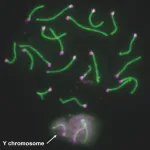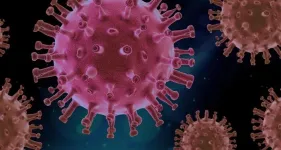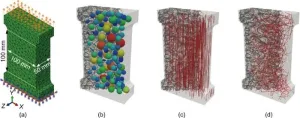(Press-News.org)
Images
More than a third of Detroit residents (36%) can't get from place to place in a safe or timely manner.
This is the main finding of a new study led by Alexandra Murphy, associate director of social science research at Mcity and assistant research scientist at U-M's Poverty Solutions, and first author Lydia Wileden, a U-M alum and assistant research professor at the University of Connecticut.
They measured this with a tool created by Murphy and her team called the Transportation Security Index. One aim of the TSI is to help local governments plan transportation investments, similar to the way food security indices clarify what kinds of food resources are needed and where.
A report issued earlier this month by the National Academies of Science, Engineering and Medicine recommended the use of transportation security indices to guide local investments in transportation resources, naming the U-M index as a good example. Detroit's transportation insecurity is more than twice the national average of 17% (established in 2022).
Murphy discusses what the TSI can reveal about issues facing Detroit and other U.S. cities.
Why focus on transportation insecurity?
The ability to get to the places we need and want to go has a huge impact on an individual's quality of life: It allows us to get to work, visit the doctor, attend parent-teacher conferences, search for housing, take care of our aging parents, visit friends, vote, and so on. Being able to do all of these things likely has implications for everything from our physical and mental health to our financial security and the flourishing of our children. Even if we're not personally transportation insecure, the security of others can affect us: for instance, employers have a vested interest in their employees arriving to work on time.
The TSI allows us to identify who is (and is not) regularly able to get from place to place in a safe or timely manner, quantify how big of a problem transportation insecurity is, and assess—through measurement and additional data collection—how this impacts outcomes relevant to individual and community well-being.
Our results show that those demographic groups most vulnerable to experiencing transportation insecurity are groups that have the least access to opportunity, including people living below the poverty line and those with disabilities. The TSI allows researchers to investigate how inequality both drives people's experience with transportation insecurity and is a result of it.
Why a transportation security index? How would it change the way transportation investments are made?
The TSI allows us to consider transportation at the individual level. For a long time, when we talked about making investments in transportation, we focused on two things: infrastructure and communities. We've long thought about improving people's ability to get around by investing in roads, bridges, sidewalks, public transportation, and so on. And when we make those investments, we think about doing them at the neighborhood or community level.
Looking at transportation insecurity at the individual level allows us to see that investments in communities don't always reach individuals within those communities. With the TSI, we can then begin to answer questions like: What shapes people's transportation insecurity? Are they unable to pay for their car to be repaired? Is public transit too far away to access? The different challenges that people experiencing transportation insecurity face may require different policy responses.
Detroit represents the first time you've applied the TSI to a specific city. What stood out to you about the results that came back from the survey?
Many of the 1 in 3 Detroiters who experience transportation insecurity have had to reschedule appointments or skip trips altogether. Our data also reveal the more relational and emotional dimensions of transportation insecurity. Of Detroiters reporting any level of transportation insecurity, 84% reported feeling bad about their situation and 56% reported that their transportation issues impacted their relationships in the previous 30 days.
What do your findings tell us about the relationship between modes of transportation and transportation insecurity in Detroit?
Given Detroit's sprawling, low-density built environment, it's not surprising that Detroiters without cars are nearly three times as likely to experience transportation insecurity compared to car owners. We also see that owning a car in the motor city doesn't fully solve insecurity. Many Detroiters have unreliable vehicles, share cars with other household members, or lack car insurance, which is very expensive in Michigan. All of this increases the likelihood of experiencing insecurity.
Regarding public transit, the vast majority of Detroiters, 82%, reported they had not used it in the past 30 days, and our results suggest the cost of transit cannot fully explain this low usage. There is research suggesting the closer one lives to transit, the more likely one will use it, but we're not seeing that in Detroit. The average transportation-insecure Detroiter lives within a three minute walk to at least one bus stop. Moreover, we find that as one's distance from a transit stop increases, the likelihood of experiencing transportation insecurity goes down.
Perhaps it is because the routes people live close to don't take them where they want or need to go. Perhaps it is because the routes available involve commutes that are too long. But having identified this relationship suggests we need more research to understand what it will take to make our transit systems better serve those who are transportation insecure.
How is the TSI being used beyond Detroit?
One example is the Mobility, Access and Transportation Insecurity demonstration program at the University of Minnesota, funded by the Federal Transit Administration. It is using the TSI to evaluate whether different kinds of investments in transportation are moving people from "transportation insecurity" to "transportation security."
The state of Minnesota and some counties are including the TSI on surveys, documenting the prevalence of transportation insecurity. By including it in future surveys, these governments will be able to see if transportation insecurity is going up or down, which will help them understand whether their investments are moving the needle.
Academic institutions have also been partnering with local communities to understand what transportation insecurity looks like in their own backyards. For instance, in addition to Detroit, the Detroit Metro Area Communities Study has also fielded surveys that include the TSI in Grand Rapids, Flint and Ypsilanti. Johns Hopkins researchers running the Baltimore Area Survey have done the same.
It is our hope that the TSI gets incorporated into more recurring, national surveys. Not only would this allow us to to track the ebb and flow of these issues at the national, state and local level, but it would also help us identify geographic hot spots where transportation insecurity is clustering in ways we may not be seeing with other measurement tools.
Murphy is also a faculty associate at U-M's Population Studies Center.
END
Transportation insecurity in Detroit and beyond
Alexandra Murphy discusses why 36% of Detroiters have trouble getting where they need to go and how a new tool could guide better transportation solutions
2025-01-23
ELSE PRESS RELEASES FROM THIS DATE:
New tool enables phylogenomic analyses of entire genomes
2025-01-23
Researchers led by electrical engineers at the University of California San Diego have developed a better way to perform the comparative analysis of entire genomes. This approach can be used to study relationships between different species across geological time scales.
This new approach is poised to unlock discoveries regarding how evolution has shaped present-day genomes and also how the tree of life is organized. The new method, named CASTER, is described in a paper published in Science on 23 January 2025.
CASTER ...
Uncovering the role of Y chromosome genes in male fertility in mice
2025-01-23
Researchers at the Crick have uncovered which genes on the Y chromosome regulate the development of sperm and impact fertility in male mice. This research could help us understand why some men don’t produce enough sperm and are infertile.
Males typically have one copy of the Y chromosome and one copy of the X chromosome, whereas females typically have two X chromosomes. Scientists know that the Y chromosome is essential for male fertility, but which genes are the most important and how they work is less clear.
In research published today in Science, a research team at the Crick resolved this question by generating thirteen different ...
A single gene underlies male mating morphs in ruff sandpipers
2025-01-23
Male ruff sandpipers engaging in the act of mating typically fall into one of three groups, with variations in how aggressive they are and how showy their plumage is, among other factors. Now, a new study reports a single gene – HSD17B2 – drives these dramatic differences among male ruff sandpiper morphs. The findings show how evolutionary changes in a single gene's structure, sequence, and regulation can drive significant diversity within a single species. The androgen testosterone plays a key role in male reproductive development. It influences ...
Presenting CASTER – a novel method for evolutionary research
2025-01-23
In a new study involving whole-genome data, researchers present “CASTER,” a tool that uses arrangements in DNA sequences known as site patterns to infer “species trees,” which are diagrams that depict the evolutionary relationships among species. The tool, which performs with exceptional accuracy and scalability and overcomes the limitations of traditional phylogenetic methods, offers transformative potential for evolutionary research. The growing availability of genomic data has revitalized efforts to construct precise species trees and model gene tree variations. However, the methodology for utilizing genome-wide data lags behind data availability. While traditional ...
Reforestation boosts biodiversity, while other land-based climate mitigation strategies fall short
2025-01-23
Reforestation is a win-win for climate and wildlife, but large-scale afforestation and bioenergy cropping may do more harm than good, according to a new study of land-based climate mitigation strategies (LBMS) for over 14,000 species. The findings emphasize the need to ensure well-intentioned climate action does not exacerbate biodiversity loss. While reducing greenhouse gas emissions is critical, increasing atmospheric carbon removal is equally essential to effectively combat climate change. LBMS considered among the most scalable ...
Seasonal vertical migrations limit role of krill in deep-ocean carbon storage
2025-01-23
The vertical migration of Antarctic krill may play a smaller role in oceanic carbon storage than previously believed, according to a year-long study in the Southern Ocean. The findings challenge conventional assumptions about the animal’s role in deep ocean carbon sequestration and underscore the need for more nuanced biogeochemical models incorporating ecological complexity. “Antarctic krill play an important role in the biological carbon pump, but without observational data, we risk using inaccurate and misleading assumptions about behaviors that influence carbon export and ...
Child mortality has risen since pandemic, new study shows
2025-01-23
While child deaths in England fell temporarily during the COVID-19 pandemic, they have now risen to new heights, a new study from researchers at the University of Bristol and based on unique National Child Mortality Database (NCMD) data has found.
The study, published in PLOS Medicine today [23 January], has shown that children were less likely to die during the pandemic lockdown (April 2020–March 2021) than at any time before or since, with 377 fewer deaths than expected from the previous year.
The number of deaths in the following year (2021-2022) was similar to before the pandemic, but in 2022−2023, there were 258 more deaths than expected from the pre-pandemic ...
Super enzyme that regulates testosterone levels in males discovered in ‘crazy’ bird species
2025-01-23
A single gene that regulates testosterone levels in a “crazy” species of shore bird controls the development of three wildly different types of males, an international study involving researchers at Simon Fraser University has found.
Ruffs have long fascinated scientists for their three types of males, known as morphs, that differ radically from each other in appearance and mating behaviours.
A new study published on the cover of the journal Science this month has discovered that these morphs are produced by a super enzyme (HSD17B2) ...
Study tracks physical and cognitive impairments associated with long COVID
2025-01-23
Two-thirds of people with post-COVID-19 syndrome have persistent, objective symptoms – including reduced physical exercise capacity and reduced cognitive test performances – for a year or more, with no major changes in symptom clusters during the second year of their illness, according to a new study published January 23rd in the open-access journal PLOS Medicine by Winfried Kern of Freiburg University, Germany, and colleagues.
Self-reported health problems following SARS-CoV-2 infection ...
Novel model advances microfiber-reinforced concrete research
2025-01-23
Researchers from Hohai University, Northwestern University, and Politecnico di Milano have introduced a pioneering mesoscale mechanical discrete model, LDPM-MicroF, to simulate the fracture behavior of micro fiber-reinforced concrete (FRC), as reported in Engineering.
Microfibers, with diameters less than 100 µm, are crucial in preventing early shrinkage cracking and reducing pore pressure during fires. However, formulating an accurate mechanical constitutive law for micro-FRC has been challenging due to difficulties in understanding ...
LAST 30 PRESS RELEASES:
Practical education: Clinical scenario-based program development
The impact of family dynamics on eating behaviour – how going home for Christmas can change how you eat
Tracing the quick synthesis of an industrially important catalyst
New software sheds light on cancer’s hidden genetic networks
UT Health San Antonio awarded $3 million in CPRIT grants to bolster cancer research and prevention efforts in South Texas
Third symposium spotlights global challenge of new contaminants in China’s fight against pollution
From straw to soil harmony: International team reveals how biochar supercharges carbon-smart farming
Myeloma: How AI is redrawing the map of cancer care
Manhattan E. Charurat, Ph.D., MHS invested as the Homer and Martha Gudelsky Distinguished Professor in Medicine at the University of Maryland School of Medicine
Insilico Medicine’s Pharma.AI Q4 Winter Launch Recap: Revolutionizing drug discovery with cutting-edge AI innovations, accelerating the path to pharmaceutical superintelligence
Nanoplastics have diet-dependent impacts on digestive system health
Brain neuron death occurs throughout life and increases with age, a natural human protein drug may halt neuron death in Alzheimer’s disease
SPIE and CLP announce the recipients of the 2025 Advanced Photonics Young Innovator Award
Lessons from the Caldor Fire’s Christmas Valley ‘Miracle’
Ant societies rose by trading individual protection for collective power
Research reveals how ancient viral DNA shapes early embryonic development
A molecular gatekeeper that controls protein synthesis
New ‘cloaking device’ concept to shield sensitive tech from magnetic fields
Researchers show impact of mountain building and climate change on alpine biodiversity
Study models the transition from Neanderthals to modern humans in Europe
University of Phoenix College of Doctoral Studies releases white paper on AI-driven skilling to reduce burnout and restore worker autonomy
AIs fail at the game of visual “telephone”
The levers for a sustainable food system
Potential changes in US homelessness by ending federal support for housing first programs
Vulnerability of large language models to prompt injection when providing medical advice
Researchers develop new system for high-energy-density, long-life, multi-electron transfer bromine-based flow batteries
Ending federal support for housing first programs could increase U.S. homelessness by 5% in one year, new JAMA study finds
New research uncovers molecular ‘safety switch’ shielding cancers from immune attack
Bacteria resisting viral infection can still sink carbon to ocean floor
Younger biological age may increase depression risk in older women during COVID-19
[Press-News.org] Transportation insecurity in Detroit and beyondAlexandra Murphy discusses why 36% of Detroiters have trouble getting where they need to go and how a new tool could guide better transportation solutions



